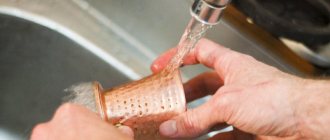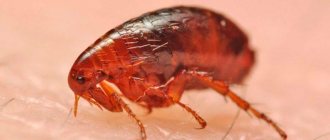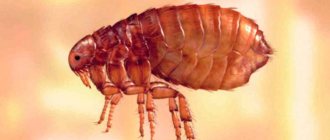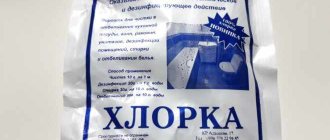Causes and symptoms of fleas in cats
Fleas appear in cats when they are infected by other animals. In this case, there may not be direct contact. Parasite larvae can be carried home on shoes. After getting on the pet’s fur, they quickly hatch and actively reproduce. Fleas can cause dermatitis, in which the cat begins to itch, characteristic rashes and damage to the skin appear. Such parasites feed on the capillary blood of the animal, and their saliva is a strong allergen that provokes the described reactions.
Fleas in cats can multiply quickly and cause itching.
Fleas are very easy to recognize. If they are present, the pet itches all the time and may shake its head. Most cats experience decreased appetite, weight loss, and sleep disturbances. In addition, fleas are carriers of helminths, which provoke severe disturbances in the functioning of the pet’s body. To detect parasites, it is enough to move apart a few hairs. Particular attention should be paid to the withers area; as a rule, there are the most fleas there. The parasite resembles a black or brown miniature midge that jumps high and also moves very quickly.
The flea feeds on the pet's capillary blood
Attention! Don't underestimate the presence of fleas. Such blood-sucking parasites can cause diseases not only in pets, but also in people. At the same time, fleas can carry such dangerous pathologies as typhoid, salmonellosis and hepatitis virus.
Kerosene - with caution
Another home remedy that is used to treat cats suffering from fleas is kerosene soap. It should be noted right away that this remedy cannot be used in weakened and sick animals, and in young animals. Zoo shampoo with kerosene is prepared from 200 grams of laundry soap and 100 grams of kerosene, which are dissolved in 10 liters of warm water.
In this solution, you need to carefully wash the cat so that the solution does not get into its eyes and ears. After washing your pet, you must rinse thoroughly so that no kerosene solution remains on the fur.
How to rid a cat of fleas using folk remedies is up to each owner to decide individually, taking into account the age and health status of their furry pet. At the same time, it is important not to forget about treating the room where the animal is located.
It is necessary to treat the cat's bedding or replace it with a new one. Upholstered furniture and carpets must be treated, as they can be contaminated with flea eggs and larvae. After treating your cat and other animals, you must regularly inspect all pets. This will prevent new infections and protect cats and their owners from various diseases.
Traditional methods of treatment
Folk remedies should be used only after prior consultation with a veterinarian. It must be remembered that such treatment methods may not always be effective, especially in the presence of a significant number of parasites. In order to achieve a positive result, it is recommended to use several methods at once.
Cats may be allergic to some folk remedies. It is important to monitor skin reactions during the procedure. If alarming symptoms occur (redness, itching, rashes, vomiting and diarrhea), you should abandon the chosen method and consult a doctor.
Mechanical method
This method is effective only when used in conjunction with anti-blade treatment. If you do not additionally use any anti-parasite remedies, this procedure will not bring any results. Therefore, before you start combing, it is recommended to treat your pet’s fur with any anti-blade shampoo or tar soap. The procedure should be repeated several times a day.
Algorithm of actions:
- Wear gloves. This is a prerequisite, otherwise you can get some kind of infection from fleas.
- Take a fine-tooth comb and comb the cat's fur against the direction of hair growth.
- Gently comb out the parasites, using your fingers to select the larvae, which most often attach closer to the skin. All fleas should be thrown into a jar of boiling water.
- After combing against the grain, you need to do the same only in the opposite direction (according to growth).
A total of up to 5 procedures may be required. It all depends on the method of removing parasites. Even if fleas are completely eliminated, it is necessary to comb out again after 7 days.
Combing fleas from a cat should be done with a special comb.
The mechanical method is not suitable for everyone. Your pet may not like this method because it takes quite a lot of time. This is especially true for active animals accustomed to constant play.
Tar soap
Tar soap is not only a safe, but also a useful way to get rid of fleas and has an antiseptic and wound-healing effect. To eliminate parasites, it is most convenient to use a liquid product. Of course, the animal may not like soap, since it has a pungent odor, but this method in most cases does not cause adverse reactions.
Tar soap has an antiseptic and anti-inflammatory effect
How to use the product:
- Fill the bathroom with hot water. It should be remembered that a comfortable temperature for a cat is 39–40 degrees.
- Rinse the animal's fur and apply tar soap, evenly distributing it over the entire surface of the body.
- Wait a few minutes and rinse off the foam thoroughly.
- Wrap your pet in a towel. When the fur is dry, comb out the fleas.
Attention! Under no circumstances should soap get into your pet's eyes or mouth. The muzzle area must be treated very carefully.
A friend has a cat who at one time was periodically itching. At first she didn’t attach much importance to it, but then she noticed that the pet had fleas. I decided not to use chemicals and bought tar soap. Its smell, of course, is not for everyone, but it is a very effective remedy. After washing the cat 3 times using this soap, a friend noticed that all the parasites had disappeared. In addition, the cat’s fur became fluffy and soft. This soap can eliminate pathogenic microflora and is especially effective against fungi.
Medicinal herbs
To eliminate this problem, you can use the following herbs:
- Sagebrush. Medicinal raw materials do not have a toxic effect on the body and do not cause allergic reactions. To process one animal, you will need 20 g of raw material, which needs to be filled with 500 ml of water and put on fire. Cook for 10 minutes, then let sit for another hour. Then filter and add 1 drop of lavender essential oil. After this, rinse the pet’s fur with the resulting liquid and wrap it in a towel. Allow the animal to dry and comb it. The procedure must be repeated 2-3 days in a row.
- Tansy. Dry raw materials in the amount of 20 g should be poured with 600 ml of boiling water and allowed to brew for about 2 hours. Then filter, heat slightly (up to 40 degrees) and rinse your pet’s fur. Repeat the procedure 2-3 days in a row. When using this method, it is important to comb out the parasites.
- Celandine. This remedy can provoke an allergic reaction, so using it too often is not recommended. First of all, you need to prepare an infusion. For this, 1 tsp. dry herbs should be poured with 300 ml of boiling water and left for an hour. Then strain the liquid and, moistening a cotton pad in it, treat the pet’s fur. You need to do this for several days in a row. It is important to ensure that the cat does not lick the infusion from the surface of the fur, so it is recommended to use a special collar. After the pet has dried, it is necessary to comb it out.
- Geranium and lavender. The herbs need to be mixed in equal proportions and take 60 g of raw material, which should be poured into 1 liter of water and cooked for a quarter of an hour. Then cool to 40 degrees and filter. Use to rinse the animal for 2-3 days in a row. After the wool has dried, comb it out, as in other cases.
If, when using raw materials, the pet’s itching increases, the cat becomes lethargic and the appetite worsens, then this is considered a manifestation of intolerance to the plant component. In this case, it is recommended to abandon the use of herbs and use another method.
What herbs will help get rid of parasites - photo gallery
Wormwood does not cause allergic reactions
Celandine should be used with caution
Geranium has a pungent odor
Lavender eliminates tissue swelling
Tansy effectively eliminates fleas
Garlic and rules for its use
Garlic is considered one of the most effective remedies that can get rid of the problem in 1-2 times. The only thing that needs to be taken into account is the possible occurrence of allergic reactions in the pet. They appear infrequently, but can cause burning and skin rashes.
Garlic is the most effective flea remedy
Algorithm of actions:
- Peel 6 cloves of garlic and grate them.
- Pour 1 liter of warm (not hot!) water.
- Let it brew for 10 hours, then strain and add 1 tsp. brewer's yeast.
- Mix the liquid thoroughly.
- Dip a cotton pad in the product and rub the resulting medicine into the pet’s fur.
- After a day, bathe the animal with shampoo.
Brewer's yeast can be purchased at the pharmacy
When using garlic and brewer's yeast, it is important to ensure that the resulting liquid does not enter the pet's gastrointestinal tract. To do this, it is strongly recommended to use a collar, otherwise the cat may experience serious complications.
Essential oils
Essential oils can be used for treatment:
- Rosemary. It is most convenient to use this oil for bathing the animal. To do this, you need to fill a basin with warm water and add 2 drops of rosemary ether. Mix everything thoroughly and can be used to bathe your pet. This method is recommended to be combined with the use of tar soap. In some cases, one procedure will be sufficient.
- Geranium and lavender. Pour 2 cups of boiled warm water into a container with a spray bottle and add the indicated essential oils, 1 drop at a time. Shake the contents thoroughly and use to spray your pet's fur 2 times a day. On the second day, comb out.
- Lemon and mint. These essential oils are recommended to be added to cat bathing shampoo. Two drops are enough to achieve results. You should bathe your animal very carefully. It is necessary to ensure that shampoo with oils does not get on the face. After the wool is dry, comb it out.
Attention! Essential oils can only be used in the quantities indicated. In no case should you exceed the dosage, otherwise a severe allergic reaction may occur.
What essential oils can be used - photo gallery
Rosemary essential oil helps relieve inflammation
Geranium essential oil promotes tissue regeneration
Lavender essential oil is effective in the fight against blood-sucking parasites
Peppermint essential oil produces an antiseptic effect
Lemon essential oil repels fleas
Use of salt
Regular table salt can help fight blood-sucking parasites. This remedy is effective and safe and can be used even in weakened animals. You only need to use the product once. It is best to purchase fine salt for these purposes, since it is the easiest way to prepare a solution.
Table salt is a safe method to help eliminate fleas
Algorithm of actions:
- Take 10 liters of warm water into a basin and add 3 tbsp. l. salt. Mix everything thoroughly until all the grains are dissolved.
- Place the cat in the basin, soap it with tar soap and wait a couple of minutes.
- Then rinse off the soap with saline solution.
- Dry the wool thoroughly, then comb it out.
If a cat has severe scratching on its body, the saline solution can cause tingling. Therefore, if your pet has wounds on the skin, it is best to refrain from such a procedure.
Pine sawdust
Pine sawdust has a specific odor that fleas cannot tolerate, so this product is used as an auxiliary treatment method. The raw materials are placed under the pet’s bedding or sewn into it, and also placed in the corners of the living room so that the parasites leave the area faster. It should be understood that pine sawdust is not able to rid an animal of a large number of fleas, so this method is recommended to be combined with those presented above.
Pine sawdust can repel fleas
This method is environmentally friendly and safe for both the cat and the residents of the house. Pine sawdust has a pleasant and light pine aroma, which does not cause discomfort to pets and people, but repels various insects.
Hellebore water
This product is one of the most effective, but at the same time not entirely safe for your pet. If hellebore water gets into the gastrointestinal tract, severe poisoning with subsequent death is possible, so the liquid must be used with extreme caution.
Hellebore water is effective against lice, fleas and lice-eaters
Sequencing:
- Wear gloves and place the animal in the bathtub or on the floor.
- Dip a cotton pad in hellebore water and treat the entire coat with the liquid, except the muzzle and anus.
- Wrap your pet in a towel and wait 15 minutes.
- Then rinse thoroughly with shampoo.
- Repeat the procedure in a week.
Attention! Under no circumstances should hellebore water be applied without wearing gloves, as this product is toxic.
Vinegar to the rescue
Vinegar has been used for decades to combat lice and fleas. To enhance the effect, it is also recommended to use ammonia. Cats really don't like this smell, but the results are worth a try. You need to add 2 tsp to 200 ml of vinegar. ammonia.
Regular table vinegar is suitable for this procedure.
Spray the resulting mixture over the surface of the wool using a spray bottle. Then wrap the animal in an old towel or plastic, leaving the muzzle outside. After 10 minutes, rinse thoroughly with shampoo. Then dry the wool with a hairdryer. As a rule, one procedure is enough.
Ammonia is harmful to parasites
To treat cat hair, you should not use vinegar essence, which is very concentrated and can cause irritation. A regular table version of 6 or 9% is suitable.
Lemon infusion
To get rid of the problem, you can use lemon infusion. To do this, you need to wash 1 citrus fruit and cut it, along with the peel, into small pieces. Then pour 600 ml of hot water and leave for 12 hours. Then filter the liquid and pour it into a spray bottle. Apply to spray wool 1-2 days in a row. After the animal has dried, it needs to be combed thoroughly. If necessary, you can repeat the procedure.
Lemons have an unpleasant aroma for fleas
After combing out fleas, the cat's fur should be washed with shampoo. This is necessary in order to prevent allergic reactions that your pet may experience to citrus fruits.
How to remove fleas without using chemicals - video
Fleas? Very bad…
The flea is a person’s most faithful and constant companion in life. We have been unable to get rid of this little creature for many millennia. Hordes of her ruthless accomplices occupy our homes to this day, causing a lot of problems and by no means minor troubles for both people and their pets - dogs and cats.
Is it really impossible to get rid of fleas once and for all?
How to protect your pets from fleas?
It turns out that it's not that simple. Ectoparasite insects, which include fleas, are incredibly resilient and adaptable. One destroyed one is replaced by thousands of new blood-sucking creatures. Up to two thousand species of fleas are known, about sixty of which live in our latitudes. They live not only on domestic animals, but also in human homes: in cracks in the floor and walls, carpets, upholstered furniture, clothes, annoying both people and their pets with bites. Such a neighborhood causes a lot of trouble, and in advanced cases, it is possible to evict uninvited tenants only with the help of a complete sanitary treatment of the house.
The first symptom of a flea infestation is that the animal begins to become restless, chewing and scratching furiously in areas where it feels itchy from flea bites. Examine your pet's fur and skin - you will definitely notice, if not the parasites themselves, then traces of their presence: eggs or excrement. In advanced cases, the animal develops dermatitis, weeping eczema that is difficult to treat, and alopecia. Small puppies and kittens are especially affected by fleas.
Pets cannot get rid of fleas on their own
Considering that fleas carry pathogens of up to three dozen diseases dangerous to humans, the question of how to get rid of parasites is very important. Serious infections and parasitic problems are transmitted through the bites of these blood-sucking insects:
- plague;
- encephalitis;
- anthrax;
- listeriosis;
- salmonellosis;
- fungal infections;
- tapeworms.
Even if there is no infection, flea bites are very unpleasant for humans in themselves: they cause itching, redness, and severe allergic reactions.
It's good that they are small...
When magnified many times, the baby flea looks like a monster from a science fiction horror movie.
Imagine for a moment that the flea has grown to at least the size of a cat - it’s better not to think about the scale of a tiger. And if you also take into account the flea’s ability to jump to a height almost three hundred times greater than its own size...
Meet the flea - a scary monster and world record holder in high jumping
The flea does not live long, but it is fruitful: in two years, the female manages to give birth to up to five hundred similar individuals, each of which, within a month after birth, also begins to actively reproduce and reproduce.
The flea's body is ideally designed to hide in animal fur.
The nimble blood-sucking insect has perfectly adapted to a parasitic lifestyle. A flea maneuvers through animal fur like a snake in the jungle. It is very difficult to catch it, and once caught, crush it: the flattened body of the small parasite is reliably protected by a hard chitinous shell. Neither a dog nor a cat is able to cope with the invasion of bloodsuckers. How to help your pet?
What to do with them?
Declare a merciless war on them! There are no and cannot be compromises in the fight against parasites. Or will you continue to provide housing and food for these disgusting little monsters? And in response they will begin to torture you, your children and animals - literally drinking blood, biting painfully and infecting you with all sorts of illnesses...
Patience and steadfastness are your main weapons
Wash, vacuum, freeze. Frequent cleaning of the room with washing and vacuuming is, of course, a preventive measure. But by creating unfavorable conditions for the existence of fleas, it will prevent parasites from feeling at ease on your territory.
And the fact that the territory itself will become much cleaner and more comfortable - well, take this as a pleasant bonus of your war. After all, in everything bad there must be at least something good...
The most important thing is cleaning the house
Ventilate the room more often, especially in winter - these small creatures love not only comfort, but also warmth, and cannot stand the cold at all!
Cold kills fleas
Brush your animals every day. Daily brushing of your pet's fur with a fine comb helps mechanically remove fleas. Of course, this should be done on a walk, not at home. The procedure will not get rid of parasites completely, but in combination with other means, the unpleasant problem will be solved.
And the fur of your dog or cat will look better, more well-groomed, and the house will be cleaner.
It is advisable to comb fleas out of fur daily.
It is better that the comb is metal, and its teeth are hard and as frequent as possible. But even daily combing will not remove all adult parasites and their eggs from the fur, and the procedure will definitely not stop new fleas.
What products can be used for pregnant cats and kittens
To eliminate fleas in pregnant females and kittens, you can use:
- tar soap;
- medicinal herbs (except celandine);
- essential oils;
- table salt;
- pine sawdust;
- lemon infusion.
When treating, you need to follow the dosage, this is especially important when using essential oils. In addition, if the chosen remedy does not help, then it is undesirable to use it several times in a row to eliminate fleas in pregnant females and kittens.
Advantages and disadvantages of folk remedies
Advantages of using traditional methods:
- the possibility of using many methods during pregnancy;
- you can combine several methods at once;
- no harmful effects on the body;
- budget savings.
Flaws:
- It is not always possible to get rid of fleas in one go;
- there is a risk of allergic reactions;
- some can be inconvenient to use.
If there are a large number of parasites, folk remedies often do not give the desired result and you have to resort to specialized drugs.
How to remove fleas from a pregnant or lactating cat
Most veterinarians do not recommend the use of insecticidal preparations for treating pregnant and lactating cats unless the infestation poses a critical threat.
However, fleas must be gotten rid of because they carry tapeworms. In addition to folk remedies for treating pregnant and lactating cats, you can use:
- Stronghold drops - can be used on pregnant cats.
- Advantage drops for a nursing cat. In addition to protecting the pet itself, the drops eliminate fleas on the litter, that is, they also protect the offspring.
Important! If a pregnant or nursing woman is weakened, flea treatment is carried out only under the supervision of a doctor.
Disinsection of premises
Rules for disinfestation of premises:
- If you have an animal, you need to wash the floors in your house every day. To eliminate flea larvae in an apartment, add vinegar to the water. Use the resulting solution to wash the floors and wipe the furniture and bedding of the animal with a damp cloth. For 1 liter of water you will need 1 tbsp. l. vinegar.
- It is recommended to place fresh wormwood and mint in the corners of the apartment. This smell repels insects.
- To re-treat the room, it is recommended to add chlorine-containing products to the water.
- After getting rid of fleas, the animal's bedding must be thoroughly washed at a temperature of 90 degrees. Then iron it with an iron.
- To prevent the reappearance of fleas, it is recommended to spray the room and furniture with a soda solution. For 1 liter of warm water 1 tbsp. l. facilities.
Fresh mint is a good remedy for killing fleas in an apartment.
Attention! If the animal has a lot of fleas, then professional help may be required to thoroughly disinfest the premises.
Lemons
One of the most effective natural flea remedies is citric acid, which makes lemon juice a widely accepted home remedy for fleas.
You can spray your cat's fur with a solution made by boiling a sliced lemon or two (let the lemons sit for a few hours), then drain the liquid before pouring it into a spray bottle.
Gently apply the solution to your car's fur—just avoid his or her eyes and monitor your pet for redness or other signs of irritation—and repeat the treatment as needed until the fleas are completely gone.
If your cat hates water—as most cats do—you can also try using a comb soaked in the solution to brush out the fleas.
If you are concerned about lingering fleas and flea eggs, add a cup of lemon juice to the laundry when washing your pet's bedding to help get rid of any remaining bugs.
Prevention measures
Prevention rules:
- Wear an anti-flea collar on your pet to prevent infection.
- Once every 3 months, wash your pet’s bedding and iron it.
- Wash floors daily with chlorine or soap suds.
- An animal that is often outdoors should be bathed once every 2 months, a domestic animal - once a quarter.
- Check your pet's fur weekly for fleas and larvae. Pay special attention to the withers.
Fleas are carriers of helminth infections, so after treating the animal for blood-sucking parasites, it is advisable to also give the drug against worms.











